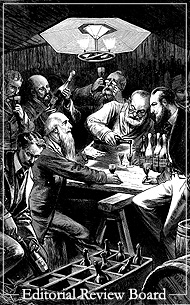
|
 |

A Publication of M2 Communications
jack-daw [JAK-dah], n. 1. a glossy, black, European bird, corvus monedula, of the crow family, that nests in towers, ruins, etc.; has a proclivity to collect bright objects that attract its attention; can include bits of ice, things round or square, twigs, filaments of light bulbs; specialist on the lookout of what fits the construction of its nest.
jackdaw journal [JAK-dah JERN-al], n. 1. a repository of bright objects — wit, wisdom and whimsey — collected and/or created by Michael McKinney. 2. a web log or blog

|  |  |

What's a Billion Dollars?
April 2, 2007
|
 |
The New York Times ran an article by Austan Goolsbee on Why Do the Richest People Rarely Intend to Give It All Away? following the listing by Forbes on the world's billionaires. He cites a report written by Professor Carroll and inserts into an illustration to help us comprehend the kind of wealth he is referring to. It does give one pause.  Professor Carroll says the super-rich can't be accumulating the money with the intention of spending it, either, because no one could spend that much. To see his point, take Oracle's founder, Lawrence J. Ellison. Mr. Ellison's net worth last year was around $16 billion. And it will probably be much bigger when the list comes out in a few weeks. With $16 billion and a 10 percent rate of return, Mr. Ellison would need to spend more than $30 million a week simply to keep from accumulating more money than he already has, to say nothing of trying to spend down the $16 billion itself.
If it isn't to spend, to give to their children, or to give to charity, then why do the rich save so much? Professor Carroll says maybe they love money, not for what it can buy but just for its own sake. Perhaps they get something different from having money--clout, power, the ability to dominate an industry. Or perhaps these are just competitive people who care about their position compared with other people on the list.
* * *
|

How Film Noir Got Its Look
April 5, 2007
|
 |
 In the Winter 2007 American Art Quarterly, there is an interesting article about how film noir got its look. In the Mind of a Madman by professor Louis Markos, traces the influence back to the silent films of the German Expressionist movement. He suggests that the prototypal Expressionist art work is The Scream by the Norwegian Edvard Munch. Germany's defeat in World War I and the social instability that followed nurtured the movement. "The works of the Expressionists would grow increasingly macabre, morbid and decadent as artists--all heirs of Freudian psychoanalysis--delved deeper into the dark regions of the subconscious. The artistic theories and methods of the Expressionists left an indelible mark on the history of the cinema. The first film to embrace Expressionism and to earn itself immediate, international recognition was The Cabinet of Dr. Caligari (1919)."
During the occupation of France, the French were forbidden to see American movies. Several years later, when Paris was liberated and the French rushed out to see their beloved American pictures, they noticed a change had occurred. The films were darker than they remembered: darker in their lighting, in their mood and in their themes. They called these strange new works film noir ("black film"), and the name has stuck.
In America, the noir genre can be credited to the fusion of both the "hard-boiled school of fiction that began in the late 1920s--like Dashiell Hammet's The Maltese Falcon and Raymond Chandler's The Big Sleep--and social conditions born out of the Great Depression and realized in gangster films of the 1930s--like Howard Hawk's Scarface (1932) and Raoul Walsh's They Drive by Night (1940). They brought to the screen "a rich gallery of anti heroes on both sides of the law."
Tough, cynical and unsentimental, the solitary protagonists of film noir live out their lives in a seedy, urban world devoid of family or any other traditional support system....In keeping with its dual literary/sociological origins, film noir will often allow its nonconformist anti-hero to think he is the master of his own fate and the author of his own code, while presenting him as being trapped in and formed by socio-economic forces outside his control.
What distinguishes the noir look from the Expressionistic look is the increased realism that the American directors brought to it. By toning down the macabre, grotesque excesses of the German silents and replacing them with more subtle visual techniques, noir directors suggested that the fear, and instability expressed in The Scream and Caligari could co-exist side-by-side with a dull, featureless urban setting.
* * *
|

The Prophet Isaiah on Foreign Policy
April 10, 2007
|
 |
 From the The Review of Faith and International Affairs Winter 2006, I found an interesting perspective on foreign policy that is worth thinking about. It's from Scott M. Thomas, an economist at the University of Bath and author of The Global Resurgence of Religion and the Transformation of International Relations . He explores "Isaiah's vision of human security": "Isaiah's famous oracle (Isaiah 2:4-6) is embedded in a religious narrative that expresses Isaiah's theology of international relations. This theology shows how cultural and religious authenticity is related to peace, security, and economic development. Isaiah's narrative is about the decay of Israel's religious life, not the absence of a religious life as in a modern secular society. Isaiah is concerned about the decay, corruption, and distortion of genuine religion by a people who think they are being religious and fulfilling the demands of worship and Torah obedience (Isaiah 1:2-6; 2:6-22; 3:1--4:1; 5:1-7, 8-30). Yahweh's judgment of their disobedience through Isaiah's oracles focuses on the paradox of how an outwardly 'religious' nation in terms of ritual and public worship can be, from Yahweh's perspective, a godless nation. Dramatically, Isaiah asks, how can a people truly worship Yahweh when they have blood on their hands? They lack knowledge, discernment, or understanding of what is really going on in domestic and international politics because they are no longer trained by the Torah to interpret the world in this way (Isaiah 1:16; cf. 10:6; 29:13-14)."
For Thomas this then begs the question: "What is Judah or Israel (for)? This is the question underlying Isaiah's prophesying. By analogy today we might ask, what is the United States (for)? Or the European Union? Or any modern political entity that wields power? These are questions of identity and significance, and social constructivists have shown us that choices in foreign policy cannot be reduced to problems in quandary ethics. A state has to have a national self before it can have a national interest. What kind of polity does a people seek for itself in the world, and what kind of world does it seek for its polity? Questions of meaning, identity, and foreign policy are inextricably bound up.
"Isaiah's criticism of Judah's foreign policy occurs because its rulers have a narrow conception of national security that underplays the importance of cultural authenticity for genuine human development. They sell out their birthright and abandon their responsibility to promote shalom, settling for the immediate gratification of idolatry, political stability, and material prosperity. All this occurs in a society that while it claims to be living by the Torah and truly worshiping Yahweh, is really based on injustice and economic oppression. Does this sound familiar?"
“Isaiah’s Vision of Human Security.” is rumored to be published in Swords into Plowshares: The Prophet Isaiah and International Relations Theory edited by Raymond Westbrook and Raymond Cohn, in 2007 from Palgrave Macmillan.
* * *
|

Iowa: They're Not Just Watching The Corn Grow
April 12, 2007
|
 |
 The April 9, 2007 Publishers Weekly reports: Iowa leads the nation in the production of pork, corn and soybeans.  But there's much more to this state than fields and farms. The Hawkeye State also leads the nation in adult literacy, with a 99.2% rate. In fact, Iowans read more books per capita than do the residents of any other state, a habit no doubt further perpetuated by the popular "All Iowa Reads" statewide reading program, now in its fifth year.
* * *
|

What's New?
April 19, 2007
|
 |
 Real estate sales trainer Mike Ferry seminar attendee shouts, "Got any new material?" Mike gently replies, "Got any new problems?" Then, persistent questioner, "Are you gonna cover the same thing as last year?" Mike replies, "Are you still doing the same thing as last year?"
* * *
|

Fractured English Department
April 22, 2007
|
 |
 These are actual signs from foreign countries written for the needs of English-speaking travelers.
Cocktail Lounge, Norway: Ladies are requested not to have children at the bar. On A Highway, Denmark: Take notice when this sign is under water, road is impassable. On A Restroom Hand Dryer, Prague: Do not activate with wet hands. In a Cemetery, Moscow: Persons are prohibited from picking flowers from any but their own graves. On The Grounds Of A Private School, France: No trespassing without permission.
* * *
|

Journalist David Halberstam Killed In Car Crash
April 24, 2007
|
 |
 Pulitzer Prize-winning journalist David Halberstam was killed Monday in a car crash south of San Francisco. He was 73 and lived in Manhattan. He was the author of 21 books including "The Best and the Brightest," "The Breaks of the Game," "The Reckoning" and "October 1964."
Halberstam was a passenger in a car making a turn in Menlo Park, California, when it was hit broadside by another car and knocked into a third vehicle, said the San Mateo County coroner. He was pronounced dead at the scene. The man who was driving Halberstam, a journalism student at the University of California, Berkeley, was injured, as were the drivers of the other two vehicles. None of those injuries were called serious.
Halberstam was killed doing what he had done his entire adult life: reporting. He was on his way to interview Y.A. Tittle, the former New York Giants quarterback, for a book about the 1958 championship game between the Giants and the Baltimore Colts, considered by many to be the greatest football game ever played.
Halberstam came into his own as a journalist in the early 1960s covering the nascent American war in South Vietnam for The New York Times. His reporting, along with that of several colleagues, left little doubt that a corrupt South Vietnamese government supported by the United States was no match for Communist guerrillas and their North Vietnamese allies. His dispatches infuriated American military commanders and policy makers in Washington, but they accurately reflected the realities on the ground. For that work, Halberstam shared a Pulitzer Prize in 1964.
Below is a picture of Mr. Halberstam in his office. (1993)
* * *
|
|
 |

|
|